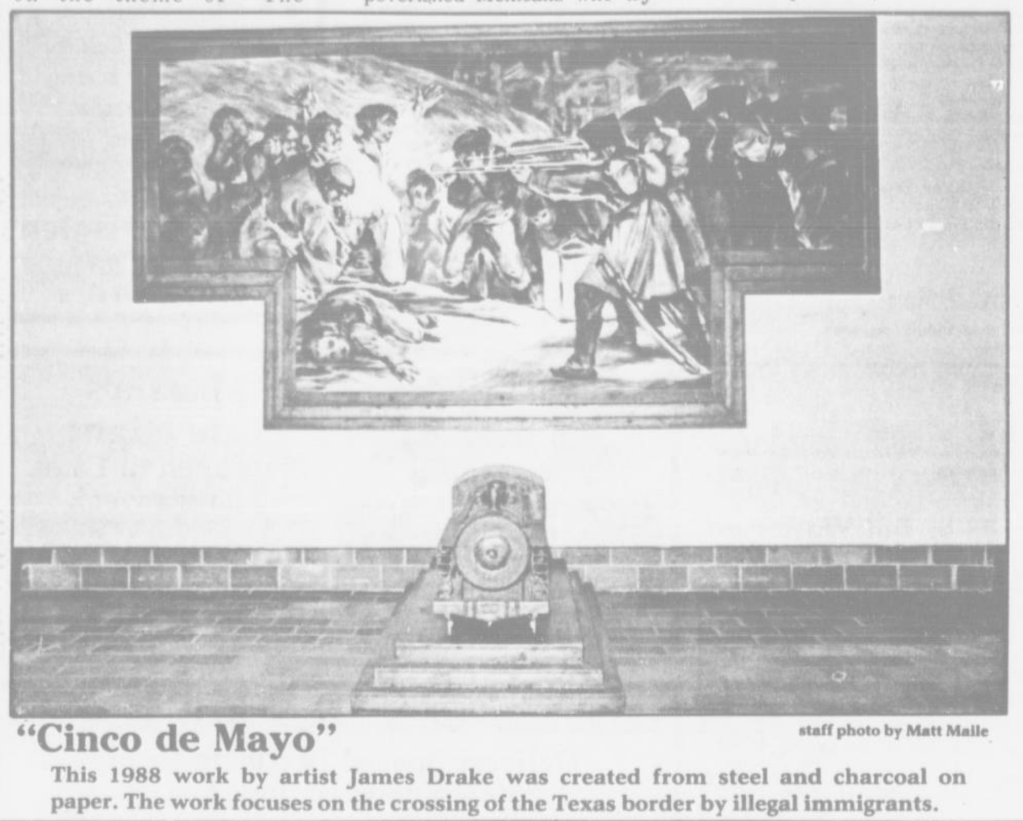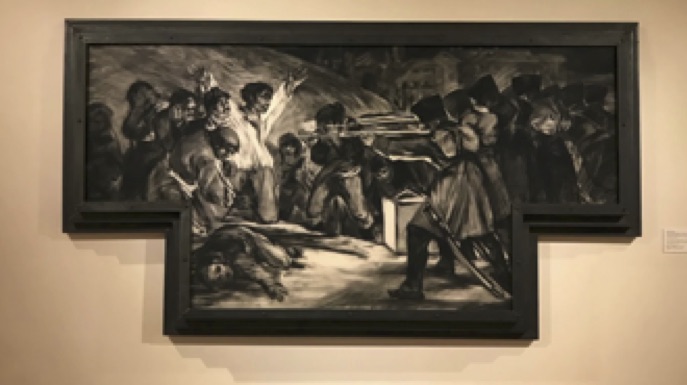In Fall 2020, students led by Associate Professor Louise Siddons created a digital project documenting the art exhibition history of Oklahoma State University, with the assistance of Digital Scholarship Librarian Megan Macken. Students used the digitized archive of the student newspaper, the Daily O’Collegian—today the O’Colly— to construct a database of exhibitions held between 1960 and 1999.
Here on the collection blog, we’re featuring reflective essays written by students about their work on this project, based on the research they did to compile the online exhibition history. This week’s essay is by Emily Albiter. It has been edited for length and clarity.
The exhibitions held between the years 1990-1994 focus on contemporary art. While few common themes emerge, they do seem to have common goals: attracting the attention of a wide audience, for example. There are many different exhibitions and no two were the same, but the ones that stood out to me are the “Machismo” and “Visions of India” exhibitions. The 1990 “Machismo” exhibition was described intriguingly as dealing with “emotion, nudes, and guns,” and 1992’s “Visions of India” offered fascinating subjects that enticed people to go see the exhibition.
Many of the exhibitions featured in the O’Colly were organized by outside individuals, who were often visiting artists. The O’Colly often featured these artists in front page news articles, and frequently interviewed them. For example, in the “Wood Engravings” exhibition, the artist, Barry Moser is featured on the Second Front page in an article written by Saira Rashid. The newspaper tended to report more facts about the “when” and “where,” rather than the “who,” and only seemed to interview visiting artists or art organizations rather than visitors.

When the “Machismo” exhibition opened, the artist, James Drake, wanted his art to project the emotions and pain of those crossing the Southern border. “Machismo” is masculine pride, or asserting toughness, and Drake personifies this through his works. In the artwork, Cinco de Mayo, Drake is focusing on the pain and suffering that is prominent when immigrants are crossing the Southern Texas border. His creations “contain very little work about hope, freedom, or potential riches. The story in this show is one of struggle and death.” The O’Colly article, written by features reporter Caroline Baker, regards Drake highly.
Drake based this specific art piece on the journey that impoverished Mexicans chose to travel because of the danger and the suffering they experience in order to create a better life in the United States. This highlighted the violence faced by immigrants at the Southern Texas border—a commentary that is still relevant today. They are extorted and pushed to the point of death by greedy and selfish people. Drake is from El Paso, Texas, so he was and still is very close to this subject. Viewers of this exhibition understood from Drake’s art pieces how little hope and freedom there was in the situations he depicted.
Unlike “Machismo,” “Visions of India” considered the history of India rather than contemporary experiences. According to the O’Colly, “the historical aspect of the exhibit makes it an unusual one to be shown at the gallery.” The Gardiner Gallery tended to focus more on contemporary artworks rather than artifacts and historical exhibitions during this time. There is no official mention, interview, or photographs to be found about “Visions of India,” which is strange because it is a very interesting subject and the O’Colly decided not to give out any other information. There is a brief mention in the newspaper of the exhibition, but that is all.
The reporter for the O’Colly mentions the organizers set up the exhibition in conjunction with the Hyla S. Converse Memorial lectureship (now the Converse-Yates-Cate International Lecture Series). Hyla S. Converse was a professor at Oklahoma State University who was born in India and it was her artifacts that were displayed at the Gardiner Gallery (Hornberger), alongside other artifacts provided by other art department professors. This was the only current event, the memorial lectureship, that coincided with why the organizers set up this exhibition. They mentioned that it was rare for them to do so, but could not turn down the opportunity to showcase the artifacts. Not much is said about how the exhibition was received by viewers, just that “this is a little different for us, and somewhat local as well.” But it was surely a breath of fresh air for gallery visitors, as it was something completely new and exciting.

